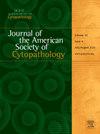Scary but innocent “blast-like” cells—potentially helpful diagnostic feature for chronic lymphocytic thyroiditis
Q2 Medicine
Journal of the American Society of Cytopathology
Pub Date : 2025-09-01
DOI:10.1016/j.jasc.2025.05.004
引用次数: 0
Abstract
Introduction
Chronic lymphocytic thyroiditis (CLT), or Hashimoto thyroiditis, is the second most common thyroid disorder diagnosed on fine needle aspiration cytology (FNAC). Accurate diagnosis is important as patients may subsequently become hypothyroid and require lifelong thyroxin supplement. Cellular lymphoplasmacytes infiltrating follicular and oncocytic cells are diagnostic features of CLT on FNAC. “Blast-like” large lymphocytes can be appreciated on DQ smears in some CLT cases and are believed to represent cells from reactive lymphoid follicles.
Materials and methods
The FNAC slides of CLT diagnosed between January 2022 and March 2024 were reviewed to evaluate the significance of “blast-like” cells in CLT. Correlation of their presence with clinical presentation of hypothyroidism was performed.
Results
Fourteen of 35 CLT cases were found to have “blast-like” cells present on DQ smears, ranging from “rare” (≤5/3 HPF) in 4 cases to “nonrare” (>5/3 HPF) in 10 cases in lymphoid-rich areas. Eleven of these 14 patients were confirmed to have clinical hypothyroidism due to CLT, with a specificity of 82%, in contrast to only 7 of the 21 patients without these cells. The specificity increases to 94% if only cases with “nonrare” large “blast-like” lymphocytes present are counted.
Conclusions
“Blast-like” cells admixed with polymorphic lymphoplasmacytic infiltrates are more frequently identified in full-blown CLT cases, and their presence shows high correlation with clinical hypothyroidism due to CLT and enhances the diagnosis. The diagnostic value of these “blast-like” cells in cases with insufficient diagnostic features for CLT requires more evaluation.
可怕但无害的“细胞样”细胞——慢性淋巴细胞性甲状腺炎的潜在诊断特征。
慢性淋巴细胞性甲状腺炎(CLT),或桥本甲状腺炎,是细针穿刺细胞学(FNAC)诊断的第二常见甲状腺疾病。准确的诊断是很重要的,因为患者可能随后变得甲状腺功能减退,需要终生补充甲状腺素。淋巴浆细胞浸润滤泡细胞和嗜瘤细胞是FNAC CLT的诊断特征。在一些CLT病例中,DQ涂片上可见“细胞样”大淋巴细胞,认为是来自反应性淋巴滤泡的细胞。材料与方法:回顾2022年1月至2024年3月诊断的CLT的FNAC玻片,评价“blast-like”细胞在CLT中的意义。他们的存在与甲状腺功能减退的临床表现的相关性进行了研究。结果:35例CLT患者中有14例在DQ涂片上发现“母细胞样”细胞,从4例“罕见”(≤5/3 HPF)到10例“非罕见”(≤5/3 HPF)的富淋巴区。这14例患者中有11例被确认为CLT所致的临床甲状腺功能减退,特异性为82%,而在21例没有这些细胞的患者中只有7例。如果只计算“非罕见的”大的“细胞样”淋巴细胞存在的病例,特异性增加到94%。结论:“母细胞样”细胞混合多形淋巴浆细胞浸润在成熟的CLT病例中更为常见,其存在与CLT所致的临床甲状腺功能减退高度相关,提高了诊断价值。这些“胚状”细胞在没有足够CLT诊断特征的病例中的诊断价值需要更多的评估。
本文章由计算机程序翻译,如有差异,请以英文原文为准。
求助全文
约1分钟内获得全文
求助全文
来源期刊

Journal of the American Society of Cytopathology
Medicine-Pathology and Forensic Medicine
CiteScore
4.30
自引率
0.00%
发文量
226
审稿时长
40 days
 求助内容:
求助内容: 应助结果提醒方式:
应助结果提醒方式:


